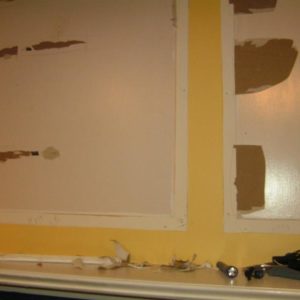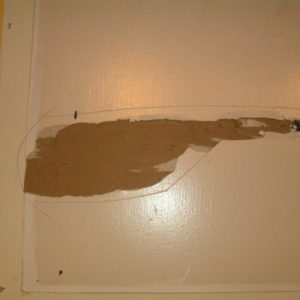We just removed 3 mirrors that were taped to the walls in our family room (by previous owners!). They used really good tape, so good that it peeled the paper off of the dry wall in some large spots. The spots are like card board that has been peeled in two. I am not sure if spackle will adhere to it. We want to paint the wall now. Can you recommend what we need to do to prepare the wall for painting? I am attaching pictures of the wall.
Thanks for any suggestions
Kathy and Will





















Replies
I did not open the piocs because the file sizes are way too big. Are the walls flat or textured? If flat, go to Lowes/HD and get a small bucket of All Purpose Joint Compound... should be about a gallon size ... and a mud knife ... 4" should work well. Make sure the paper facing is not peeling any more ... cut is with a sharp knife in necessary, and apply a skim coat of joint compound. Let it dry overnight, sand very lightly, then you might have to apply another light coat to fill any shrinkage. When that dries, prime the patched area and paint.
"When asked if you can do something, tell'em "Why certainly I can", then get busy and find a way to do it." T. Roosevelt
Man, I haven't heard anyone talk about 'Spackle' in years. Thanks! Makes me feel a bit less old, LOL.
As mentioned above, a skim coat of joint compound will do the trick. If you paint the peeled and separated face paper the way it is, the paper fibres will 'bloom' and the paint job will look like hell.
Dinosaur
A day may come when the courage of men fails,when we forsake our friends and break all bonds of fellowship...
But it is not this day.
Slightly off-topic: What do you guys use the "light" all purpose joint compound (blue bucket) for? I always have used the regular all purpose joint compound (green bucket), except when I need to get several coats up in one day. Then I go to the setting-type compound (in bags).
Are there hardness or shrinking differences? I was always taught that the stuff in the green bucket is "better" somehow, and the blue bucket stuff is a compromise. But last time I looked at the cans at HD, there weren't any significant differences written ( and weight doesn't seem like an important difference to me ).
Rick
Thanks everyone for the help. My evening is now planned, a quick trip to Lowe's for some joint compound (a.k.a. spackle for us old folks) and the work will begin.
Rick, regarding the differences in hardness and shrinkage...well that's a little to personal for me to comment on right now ;-)
Thanks again everyone.
Will
Ah, the one who took my name way back when :)
The light stuff is supposed to shrink less - but I have never done dw for a living so wait for a real answer.
i know that you cant "bed' tape with the blue, lightweight compound.
The lightweight compound (blue bucket) does not dry as hard as the green bucket. As such, it is not used for the first coat, beding tape and doing corners.You get out of life what you put into it......minus taxes.
Marv
I don't tape and spackle on a regular basis, but I find the blue seems to trowel on smoother than the green, as well as dry quicker.
just my observations, someone else may have different results.
The only diff between Regular and Topping as was explained to me is more glue in the regular. Better initial bond, topping flows out smoother.
Lightwt bucket mud seems more air entrained in the bucket.Remodeling Contractor just outside the Glass City.
Quittin' Time
Rick, I've used the "blue" top stuff on many projects for all three coats with good results. The blue stuff is drier and thicker than the green and has less "workability", but it also shrinks much less and dries slightly faster.
Recently, I switched to using the green stuff for the final coat, but blue still for most stuff.Jason Pharez Construction
Framing & Exterior Remodeling
Just the opposite. Blue is the topcoat, bed with the green. If it works for you though...
Yeah I agree with Jer. Green for the first two, blue for top is what I have heard.
Most folks seem to WANT the easier sanding on the final coat. I prefer to do as smooth a job as I can, thereby limiting the sanding to almost none -- but getting the "harder' finish. So I guess I will continue to go with green for all three when there is the time.
Thanks to all for weighing in --- I am actually surprised that it is not a settled issue.
Hey RickD. You had your chance during the recent re-registration debacle -- you could have stolen my screen name then! (I lost all my profile and forums in the process anyway.)
Rick (the original)
yeah, lost all mine too - had to keep the D since I am so well known and respected here :)
Cut a circle around the loose paper and pull off. Spot prime with a non-latex primer. A can of spray paint works fine if you have it laying around. This will keep the paper from lifting when compound is applied. Patch with compound till it disappears.
Remodeling Contractor just outside the Glass City.
Quittin' Time
Spackle would be just the thing for this. Just make sure you run some rough sandpaper (60-80) over that glossy paint that is around the edges of the places to be patched to give both the spackle and any primer some tooth.
Before you skim coat the walls you should seal the paper. Guardz a product made by Zinsser, seals the paper. Everytime you apply some mud the moisture continues peeling the paper.
Edited 8/22/2005 5:05 pm ET by dustinf
Edited 8/22/2005 5:06 pm ET by dustinf